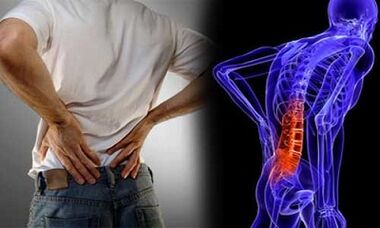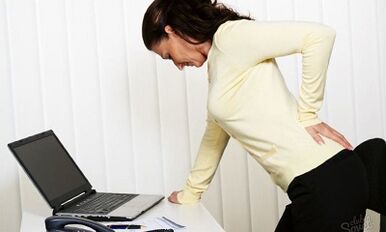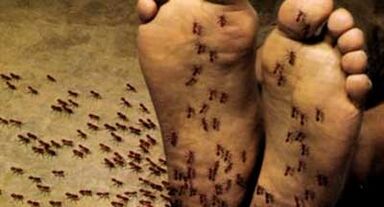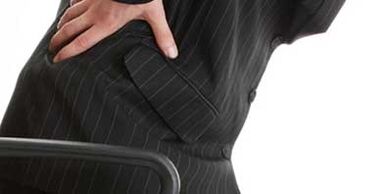Probably, you cannot find a single adult who did not know what "lumbar osteochondosis" is.On average, every third person in good health, intermediate years, and sometimes more often, had in their life an episode of acute back pain, and each fifth - sixth indicates that such problems arise regularly and are even a "source" of the hospital sheet.
However, to explain in detail what for violation has occurred in the lower back, patients are most often not able to do so.Most of them have never been examined and the treatment consisting in the form of "injections", "ointments", massage sessions generally contribute to a period of several months to one year.
If you "post" such a patient and start inquiring about the diagnosis, after having suffered a little, he will declare that he is sick of "osteochondrosis".What does this disease mean in relation to the lumbar column?
Osteochondrosis in the lumbar region - a disease or a "norm of life"?

First of all, you must say with authority: "osteochondrosis" cannot do any harm.And in any way whatsoever, it cannot manifest itself, because it is the process of dystrophy and degeneration of the intervertebral discs, that is to say the cartilage, which consist of a luscious nucleus and a fibrous ring.The intervertebral disc is cartilage and is designed to function as an “airbag” absorbing shocks, softening vertical and angular accelerations - inhibition between the adjacent vertebrae.
As you know, cartilage is devoid of nervous and vascular tissue, so that the processes that go "purely in the discs" simply cannot affect neighboring structures and do not appear in any way.A similar example in vertebronology is the hernies of the Shomorle, in which the hernial projection is reliably covered by the spongy bone tissue of the neighboring vertebra.Intervertebral discs do not hurt.
Chondrosis (the "-O" suffix indicates an increase, an increase), in this case, not quite correct.During human life is not occurring in human life and the increase in cartilage.Here, with the liver fibrosis (cirrhosis), it can be noted that the liver's brilliant structure began to develop, to the detriment of the function.
And with chondrosis (or osteochondrosis), the intervertebral discs only begin to change their configuration, under the influence of perennial charges.
They cause pressure on the neighboring vertebrae, because, according to Newton's law, each action at a static charge gives rise to the same opposition or the same reaction of support.How is osteochondrosis developing and for what reasons this happens?
The causes of "lumbar osteochondrosis"
Signs of osteochondrosis in the lumbar region (more precisely, intervertebral discs) can already be found at a young age, in particular with various violations of the musculoskeletal system.
They can be attributed, for example:
- Congenital anomalies (different leg length);
- Various types of flat feet (longitudinal, transverse);
- deformation of the spine (scoliosis);
- Spondylolistz (sliding the lower lumbar vertebra of the sacred bone forward and back).
All these diseases can cause or increase the shock load on the spine (for example, with flat feet, when the elasticity of the foot arc decreases), and with severe asymmetry of the spine, when the support function is systematically carried out due to the load on the edge of the disc.
It was known that with experiences, it was found that healthy and young cartilage, if they were given uniform and static throughout the surface, could resist up to 2000 kg and even higher for themselves.Of course, there is not such a charge in daily life, but it can increase to such values when exposed to the edge of the disc.
If the support zone is 20 times smaller and the disc will not be so healthy (for example, in old age), exposure to 60 to 80 kg (for example, falling on the ice by tilting on the side, with a load on the shoulders) can cause a destruction of the disc, which can be in the form of a protrusion or a hernia.
It is the appearance of the projection or hernia that indicates that the disc has been distorted and even "crawled" with one or more sides.And around the disc, as you know, there is no empty space.As soon as the disc begins to contact the nerve roots, ligaments and neighboring muscles, the consequences of osteochondrosis occur: reflex pain and muscle tones syndromes which make the patient turn to a neurologist, a manual therapist and a masseur.
In the meantime, the discs have a normal form and wears out uniformly, without extreme loads, then osteochondrosis of the lumbar column does not disturb the patient that the usual abrasion of teeth, with which criminals are well known.How do syndromes of reflex pain manifest?
Symptoms and signs of complicated lumbar osteochondrosis

You have already noticed that we have diligent "reproduction" bridges: ordinary osteochondosis is a completely inevitable process of ordinary aging of elastic "joints" in the type "reasonable man", because it moves vertically throughout life.And "osteochondrosis" that patients with acute pain remember a complicated condition.
We may start, with signs of radicular compression.The signs of lumbar osteochondosis, of course, are associated with pain, due to the segmental nerve spine pressed by the disc.In addition to pain, sensitive, motors and vegetative trophic disorders are possible.
Low pain in osteochondrosis has the following characteristics:
1) moving pain.It is secondary, and proceeds according to the type of neuralgia, when the swollen nerve spine reacts very "violently" to a concussion.
The pain is clear, suddenly, pulling, piercing the lower back, possibly abandoned.The pain appears and instantly intensifies, so it is called "lumbago" or "background".It is such a "component" that makes a person "resist a naracan", because any movement leads to increased pain.
In addition, the pain intensifies at the slightest cough, sneeze, constraint, laugh - any situation in which a swollen spine is shaking.
In the event that the spine is part of the sciatic nerve, the pain "pulls" through the buttocks in the popliteal pit and below, and this is called "Lombar-Algie".
2) Muscle pain.Near the nerve spine are large muscle massifs.Often, in spring and fall, they "get up" and they swell, become dense.The venous flow is difficult in them, and they are themselves a source of pain.
This pain is painful, constant and not so hard.On the contrary, it intensifies not only with a pointed movement, but also with a prolonged movement in a monotonous position (deterioration of blood supply).
- Sometimes such a myofascial syndrome occurs after exacerbation of the projection or hernia, when a net "hook" of hernia "massage" muscles and ligaments for a long time.
3) Motor disorders.Since the disc can tighten not only a sensitive spine, but also a motor spine, it is possible to develop peripheral paresis, even paralysis.With different levels of damage, the appearance of weakness in the legs is possible (for example, weakness during the climbing of the stairs on the one hand), a weakness in the foot, which leads to an altered duct.
There is a muscular hypotrophy, one leg "loses weight".Such a pure and painless disorder is rare and, which remains unnoticed, can cause a handicap.

4) Sensitive violations.They arise with pain, often exist even after the end of the pain, instead of pain.They manifest themselves by numbness, a decrease in the sensitivity of the skin of the legs by the type of "stripes", in the form of vertical stripes, a feeling of "goose-bordeaux" in the fingers and feet.
- Sometimes, with damage to vegetative fibers, symptoms are combined with hyperhidrosis, skin cooling, hair growth and nails.
These are the most general signs of complicated lumbar osteochondosis existing in the lumbar region.There are separate syndromes, for example, damage to the external skin of the thigh, or damage to the ponytail, the epiconus, the pure radiculitis or with a pear -shaped muscle syndrome - but even their brief description will take too long.
For patients, the above is sufficient, the main signs to register for a neurologist.How can you "delete exacerbation with your own hands"?How to treat lumbar osteochondrosis of the house?
What to do during the exacerbation of lumbar osteochondosis?
The basis of all treatments is the etiotropic treatment (elimination of the cause) and pathogenetic treatment (affecting the mechanisms of the disease).Symptomatic therapy played him.
With vertebrogen pain (caused by problems in the spine), things are like this:
- The elimination of the cause is the elimination of the pressure by the projection, a hernia or a spasmotated muscle on a nervous root;
- The impact on mechanisms is the elimination of muscle spasms, the restoration of venous flow in the muscles, the elimination of edema of the nerve spine and the fight against inflammation;
- The elimination of symptoms (the fight against pain, numbness, limitation of mobility) is carried out by returning to paragraph 2, because the elimination of edema and inflammation, for example, will send mobility and relieve pain.
Go by protruding and hernia
As a rule, it does not start to treat acute back pain.Almost always at the beginning, they stop pain syndrome, then, after the massage and treatment sessions of the manual therapist, all the symptoms disappear and the operation is not necessary.
The question of surgery arises with the progression of the weakness of the foot and with severe and unconscious pain within 2 months.In addition, the operation is required when compressing the central canal at high levels in which the spinal cord is located or the "ponytail".
Lumbar osteochondrosis treatment, drugs
The treatment of lumbar osteochondrosis and its complications provide for the following measures.In the sharp phase (first day - two):
- In order to reduce muscle edema and spine, a sleepless diet is indicated and the limitation of the amount of liquid used.You can even give a slight diuretic drug that saves potassium.
- Wearing a half -rigid orthopedic corset is shown, which saves the muscles from excessive movement.
- From the first days, friction ointments containing NSAIDs, the application of plaster, for example, "pepper", is shown.
- You cannot warm your back in the sharp phase.With increasing inflammation, edema increases.Therefore, all kinds of heating pads are prohibited.You can warm up, take your own heat (wool belt, warming ointments), which are not added from the outside, but, on the contrary, is removed from the depths.
- In the acute phase of osteochondrosis in the lumbar region, short -term treatment with intramuscular "injections" of NSAI and muscle relaxants can be carried out.This will help stop edema of nervous tissues, eliminate inflammation and normalize muscle tone.
During the subsequent period, after overcoming maximum pain, "injections" should no longer be taken and attention should be paid to repairer means, for example, preparations of modern vitamins of the group "B".They effectively restore altered sensitivity, reduce numbness and paresthesia.
Physiotherapeutic measures are continuing, the time comes for the conduct of exercise therapy for osteochondrosis of the lumbar column.Its task is to normalize blood circulation and muscle tone, when edema and inflammation have already withdrawn, and the muscle spasm was not yet completely resolved.
The lumbar osteochondrosis exercises of the spine should be carried out after a slight common hot up, on the "hot-up muscles".
The main therapeutic factor is movement, not the degree of muscle contraction.Therefore, in order to avoid relapses, the use of loads is not allowed, a gymnastics carpet and a gymnastics stick are used.With their help, you can effectively restore the volume of movements.
The friction of the ointments, the use of the Kuznetsov iPllicaror continues.Swimming, underwater massage, Sharko's shower are represented.It is at the amortized exacerbation stage that drugs for domestic magnetotherapy and physiotherapy are shown.
As a rule, treatment does not take more than a week, but in some cases, osteochondrosis can manifest with symptoms as dangerous as the operation may be necessary and urgent.
Complications of osteochondrosis of the lumbar column

It is, first of all, the condition when the hernia of the disc has become an independent fragment and, after penetrating the central canal, formed free sequestration.There, he can press the nerves of the ponytail, and he can suddenly (just in the gymnasium, after an episode of acute pain) develop a strong weakness or paralysis in the legs, a numbness of the perineum.
After a few minutes, brutal pain in the legs appears, then - a reflex delay in the urine, or the appearance of incontinence, develops, impotence develops.This appeared from the ponytail syndrome, as a complication of a disk hernia.In this case, an urgent intervention, a sequester elimination and a restoration of the function of the nerves of the ponytail with their decompression are necessary.
However, more often than not, other complications arise.With age, multiple hernias and projection, osteoporosis of the vertebrae appears and mobility simply decreases and the risk of acute back pain increases.These patients are sure to "take disease leave" several times a year and are often treated in sanatoriums.
Treatment forecast
Osteochondrosis of the lumbar column, the symptoms and the treatment we have dismantled above, as we have understood, is not at all a disease, but simply by an inevitable aging manifestation and premature "narrowing" of the intervertebral discs.
Can humanity be completely spared from lumbar osteochondosis?This answer can be replied in the affirmative, but we will then have to master a different style of movement: all our lives to go on all fours, or, like Ichtyander, float in the depths of the ocean, constantly moving into water since childhood.It is then that the axial and static load on the intervertebral discs will disappear, and with it the signs of "chondose" will disappear.But another problem arises: in water, such a powerful design will simply become useless and will begin to change until it disappears or will not decrease significantly.
As for the personal and individual forecasts of osteochondrosis, it all depends on the time when a person "decided to take the mind".If at that time, there is no pronounced destruction of intervertebral discs, protuberances, hernias and deformations, then, subject to a healthy lifestyle and hygiene, physical activity cannot be known to the very back of the lower back.
In the same case, when there is already a "hot spot" in the area of the lumbar region, for example, in the form of a hernia, which periodically tightens the nerve spine, then a person must particularly take care of clumsy turns, physical effort, inappropriate uprising of gravity and seasonal hypothermia, which generally causes an exacerbation of osteochondrosis of the vertebral column.



































